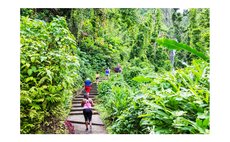The difference between soil and dirt
Why do we garden in soil, yet when we wash it off our hands or out of our clothes, it is annoying dirt? How can one item have two definitions, one positive and one negative? Soil provides food, trees, shrubs, and flowers, but dirt is a nuisance to be removed. Yet they are the same thing!
Dirt: Dirt is often rocky, silty, and void of any beneficial nutrients and microbes that healthy plants need. If you add water to a handful of plain dirt, it will not compact well, if at all. Because of these qualities, dirt does not make a good gardening medium.
Soil: Soil, on the other hand, is the perfect gardening medium, as it is rich in nutrients and microbes, and when scooped up in your hand, it will clump or form a loose ball easily — often without water being added. When earth worms are present in soil, it's a sign of fertile ground in which to grow plants. Worms will not thrive in dirt. The Soil Science Society of America defines dirt as 'displaced soil', which covers the scenario above, when you clean up after working in the garden. On a larger scale, think of how much soil gets displaced from a landslide and suddenly becomes dirt!
Soil is alive with living organisms such as worms, fungi, insects, bacteria, and organic matter. It supports life with its naturally occurring nutrients and minerals, making it a perfect planting medium. It is a complete and self-sustaining ecosystem.
Sand, silt, clay, and organic matter make up soil. The different sized particles create texture and structure, which aid in aeration and drainage. Soil color shows its mineral content. Different soil types are described by their properties.
Compost: Compost is the end product of decaying plant matter and should only be used when it has "cured" — i.e., broken down completely. Compost that has cured will look dark and have a rich, earthy smell. It must show no signs of the previous organic matter that it is made up of. If decaying vegetation is still visible in the compost, it has not yet finished breaking down and the nitrogen level in the compost is too high to safely apply on or around plants. If the compost is used at this point in the breakdown, it will burn and most likely kill plants.
Composting times vary depending on methods used to compost, so when in doubt, allow the compost to set longer or test a bit in a small potted plant before amending large quantities of garden soil with compost. Compost should be added yearly to gardens to keep the soil rich with nutrients.
When this magnificent living thing called soil leaves the garden on your hands or clothes, it gets displaced and is now defined as dirt.
Dirt is made up of sand, silt, and clay, and it may be rocky. It has none of the minerals, nutrients, or living organisms found in soil. It is not an organized ecosystem. There is no topsoil or humus, no worms or fungi. Lacking texture and structure, dirt does not compact when wet, unlike a handful of soil. The result is run-off and erosion. An old dirt road comes to mind with this definition.




